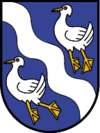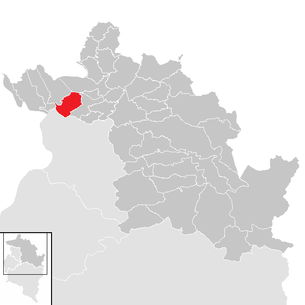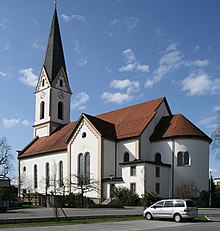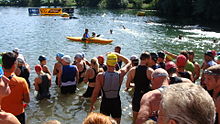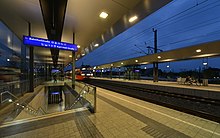Lauterach (Vorarlberg)
|
market community Lauterach
|
||
|---|---|---|
| coat of arms | Austria map | |
|
|
||
| Basic data | ||
| Country: | Austria | |
| State : | Vorarlberg | |
| Political District : | Bregenz | |
| License plate : | B. | |
| Surface: | 11.91 km² | |
| Coordinates : | 47 ° 29 ' N , 9 ° 44' E | |
| Height : | 412 m above sea level A. | |
| Residents : | 10,274 (January 1, 2020) | |
| Population density : | 863 inhabitants per km² | |
| Postal code : | 6923 | |
| Area code : | 05574 | |
| Community code : | 8 02 24 | |
| NUTS region | AT342 | |
| Address of the municipal administration: |
Hofsteigstrasse 2a 6923 Lauterach |
|
| Website: | ||
| politics | ||
| Mayor : | Elmar Rhomberg ( ÖVP ) | |
|
Local council : (2015) (30 members) |
||
| Location of Lauterach in the Bregenz district | ||
 Lauterach community, view from Gebhardsberg |
||
| Source: Municipal data from Statistics Austria | ||
Lauterach is a market town in the Austrian state of Vorarlberg with 10,274 inhabitants (as of January 1, 2020). The market town is located in the northern part of the Vorarlberg Rhine Valley in the Bregenz district between the two cities of Bregenz in the north and Dornbirn in the south.
geography
Lauterach is located in the westernmost state of Austria, Vorarlberg, in the Bregenz district south of Lake Constance at an altitude of 412 meters. 0.3% of the area is forested.
There are no other cadastral communities in Lauterach.
Neighboring communities
The market town of Lauterach borders on seven other Vorarlberg communities. Five of them are in the Bregenz district and two in the adjoining Dornbirn district . In a clockwise direction (starting in the north) these are the district and provincial capital Bregenz , the municipality of Kennelbach , the market town of Wolfurt , the district capital of Dornbirn , the market town of Lustenau and the town of Fußach and the market town of Hard .
history
In the Lauteracher Ried located in the Rhine delta (see below under “Natural monuments”) a coin depot was found during peat cutting in 1880. 24 Roman silver denarii from the 2nd to 4th quarter of the 2nd century BC Were included, the youngest dated from 110/106 BC. Three of the coins are of the Quinarius nummus type (silver quinars). Some jewelry items (a bronze ring, a silver finger ring, a bracelet made of silver wire and a pair of silver fibulae ), which presumably came from an Italian production, were also in the depot. The silver brooches were evidently the templates for similar objects made north of the Alps. Whether this depot, which dates back to around 100 BC, was BC, a religiously motivated dedication or a safekeeping in a treasure hiding place is controversial in research.
The village cooperative was founded at the end of the 5th century. The first historical mention under the name "Lutaraha" was found in 853.
Later the Habsburgs ruled the places in Vorarlberg alternately from Tyrol and Upper Austria ( Freiburg im Breisgau ). Until 1806 Lauterach belonged to the Hofsteig region , the seat of the Hofsteiggericht was in Lauterach.
From 1805 to 1814 the place belonged to Bavaria , then again to Austria. Lauterach has belonged to the Austrian state of Vorarlberg since it was founded in 1861.
According to a record by Landammann Schneider from 1808, Lauterach had 790 inhabitants, 157 houses and 341 cows.
From 1835 to 1841 there was a medicinal bath (sulfur spring with iron components) that was noble for those times in the Lerchenau district. It was founded by the manufacturer Anselm Brielmayer , but had to be closed again after a few years due to a lack of solvent customers. In 1850 the spa complex burned down.
The place was part of the French occupation zone in Austria from 1945 to 1955 .
1985 Lauterach was raised to a market town.
Population development
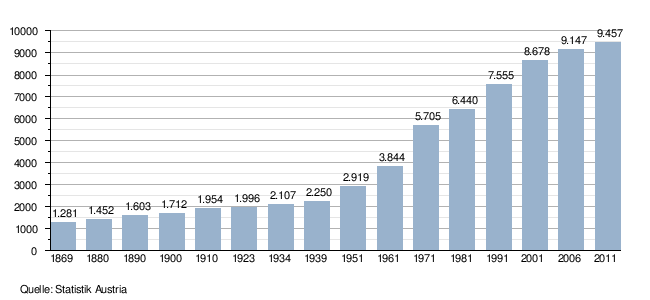
politics
The municipal council consists of 30 members and is currently composed as follows - following the 2015 municipal council elections:
- Team Mayor Rhomberg People's Party Lauterach and non-party members: 15 seats (−4)
- Freedom and independent citizen list Lauterach: 9 seats (+4)
- The Greens Lauterach: 4 seats (+2)
- Social Democratic Party of Austria (SPÖ) and non-party members: 2 mandates (−2)
Mayor is Elmar Rhomberg from the ÖVP.
Culture and sights
- Catholic parish church Lauterach hl. George
- Art in the Rohnerhaus: A private foundation mainly houses works by Vorarlberg artists from the 17th century.
- Lourdes Chapel in Kapellenstrasse
- nature
In the southwest of Lauterach there is the Natura 2000 - European protected area Lauteracher Ried , which with an extension of approx. 580 hectares represents an important local recreation area for the population of the region (the Lauteracher Ried in total has about 800 hectares). The Lauteracher Ried is an important breeding area for rare birds such as the curlew , black godwit , snipe , lapwing , lark , stonechat and whinchat, yellow wagtail and the corncrake , which is threatened with extinction throughout Europe .
The Jannersee lies in the Lauteracher Ried . From 1959 to 1961, the Janner Kies company dismantled the site of today's swimming lake .
Sports
The Jannersee Triathlon has been held in Lauterach every year in August since 1994 . In this competition for "everyone" in Lauteracher Ried, a triathlon over distances of 400 m swimming, 16 km cycling and 4 km running is held as the Vorarlberg state triathlon championship. In 2009 the two professional triathletes Yvonne van Vlerken and Peter Schoissengeier took part.
economy
In 2003 there were 208 commercial enterprises with 3410 employees and 179 apprentices on site. There were 4,243 employees subject to wage tax.
Agriculture plays an important role. The proportion of agricultural land in the total area is 74.4%.
- Companies
- Hermann Pfanner drinks
- Flatz packaging
- Gebrüder Weiss (corporate headquarters)
- i + R group
- Huppenkothen construction machinery
traffic
The Lauterach stop is on the Lindau – Bludenz railway line , the S1 trains in the direction of Lindau or Bludenz stop . There are also some Landbus Unterland bus routes that go through the town.
media
In Lauterach the ORF operates a broadcasting system for VHF . A 116-meter-high guyed steel truss mast, insulated from earth, is used as the antenna carrier. The transmitter mast is isolated from the ground, since until January 1st 1995 the ORF Radio Vorarlberg program was broadcast on the medium wave frequency 1026 kHz from this transmitter . Next to it is a smaller guyed steel truss mast, isolated from the ground, with a round roof capacity, which served as a reserve antenna for medium waves. Analog television and digital television for handhelds (DVB-H) were also in operation from this transmission system until they were switched off on April 14, 2008 and December 31, 2010, respectively. The transmitter is now a listed building because it has historical significance and is possibly the oldest still existing transmitter of the ORF. The transmission tower was built by French troops after the Second World War .
Until 2007, the studio of the local broadcaster Ländle TV was also in Lauterach.
education
- 2 elementary schools (VS Dorf and VS Unterfeld)
- Middle school
- BORG Lauterach
- Special education center
There were (as of January 2003) 1064 pupils on site, of which around 290 (as of 2007) were at general secondary schools (AHS) and none at higher vocational schools. There are also seven kindergartens in Lauterach.
Personalities
- Ernst Kolb (1912–1978), politician (ÖVP) and professor of constitutional and administrative law
- Josef Kolb (1914–1994) physicist and rector of the University of Innsbruck
- Edwin Lipburger (1928–2015), Austrian artist ( Kugelmugel )
- Kurt Greussing (* 1946), social scientist
- Bruno Pezzey (1955–1994), 84-time national soccer player
- Christoph Hagen (* 1968), politician (TS, formerly BZÖ, FPÖ) and police officer
- André Pilz (* 1972), German writer
- Julian Knowle (* 1974), tennis player, US Open double winner
- Eva Hammerer (* 1975), politician (Greens)
- Markus Weissenberger (* 1975), soccer player
- Christian Hirschbühl (* 1990), ski racer
- Veronika Morscher (* 1991), singer-songwriter and jazz singer
Web links
- 80224 - Lauterach (Vorarlberg). Community data, Statistics Austria .
Individual evidence
- ^ Susanne Sievers , Otto Helmut Urban , Peter C. Ramsl: Lexicon for Celtic Archeology. A – K, LZ . Publishing house of the Austrian Academy of Sciences , Vienna 2012, ISBN 978-3-7001-6765-5 , p. 1143 f.
- ^ Emil Gmeiner in Heimat Schwarzach , Schwarzach 1990, self-published by the community of Schwarzach, p. 83.
- ^ Christoph Vallaster: Small Vorarlberger Heilbäderbuch. Book Spezial Verlag, Dornbirn 1984, ISBN 3-900496-03-3
- ^ Bleiche, Spinnerei und Mühle Ganahl Lerchenau in: "Places - Factories - Stories: 188 historical industrial buildings in Vorarlberg" by Barbara Motter and Barbara Grabherr-Schneider, Innsbruck 2014, Haymon Verlag, ISBN 978-3-7099-3575-0 .
